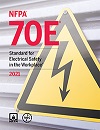
Purpose:
Every qualified employee shall be provided with electrical personal protective equipment, voltage-rated tools and appropriate test instruments shall be available to him or her to safely complete all tasks. If an employee needs additional tools or personal protective equipment, they shall obtain them according to specific documented company procedures.
Responsibilities:
Employer will:
- Strive to provide a workplace free from recognized hazards.
- Provide all the training required by OH&S regulations and the authority having jurisdiction.
- Employees shall receive all required training in accordance with NFPA 70E to effectively implement all practices necessary to work safely and avoid injury.
- Provide specific Personal Protective Equipment, (PPE) to personnel exposed to electrical hazards and ensure that it is in acceptable condition and shall be worn by all workers when required.
- Create documented rules, policies and procedures with employee involvement that affect workers and ensure workplace compliance with documented workplace audits.
- Determine who is qualified to perform justified energized work. Only the employer can determine who is qualified.
- Ensure that all qualified persons shall be trained and knowledgeable of the construction and operation of equipment or a specific work method and be trained to recognize and avoid the electrical hazards that might be present with respect to that equipment or work method.
- Ensure that a comprehensive Lock Out / Tag Out (LO/TO) Program is always used to establish an “Electrically Safe Work Condition” when required.
- Ensure that a Job Safety Plan (JSP) as per NFPA 70E is executed for all electrical work greater than 50 VAC / VDC as follows:
- Be completed by a qualified person.
- Be documented.
- Include the following information:
- A description of the job and the individual tasks.
- Identification of the electrical hazards associated with each task.
- A Shock Risk Assessment in accordance with 130.4 for tasks involving a shock hazard.
- An Arc Flash Risk Assessment in accordance with 130.5 for tasks involving an arc flash hazard.
- Work procedures involved, special precautions, and energy source controls.
Employees will:
- Abide by all rules and regulations created and provided for their protection.
- Wear all of the shock and/or arc flash PPE provided by the employer and their training.
- Be familiar with and implement all safe work practices developed and implemented for their own safety.
- Take responsibility for their own actions and strive to keep the workplace free from any additional hazards.
- Communicate any hazards encountered on the job
Training:
Workers who are exposed to an electrical hazards, and their supervisors, are required to know the following:
- When PPE is necessary
- What PPE is necessary for each electrical task
- How to properly, don, doff, adjust, and wear PPE
- The limitations of the PPE
- The proper inspection, care, maintenance, useful life, and disposal of the PPE.
Re-training is required when:
- Changes in the workplace require additional or new types of PPE
- Changes in the types of PPE to be used require new information be provided
- When changes in NFPA 70E happens, typically every 3 years
Description:
- Employees that regularly perform justified energized work shall wear arc-rated clothing appropriate for the tasks performed.
- Rubber insulating gloves with approved leather protectors compliant with NFPA 70E will be provided by the company
- Arc-rated garments compliant with NFPA 70E will be provided by company
- Protective equipment is to be maintained in a safe, reliable condition per the manufacturer’s recommendations.
- Protective equipment and tools shall be visually inspected before each use.
- If there is any doubt concerning the safety of the equipment or tool the employee shall contact their supervisor.
- The supervisor shall determine if the item should be taken out of service or subject to examination by a suitably trained third party person and retested if necessary.
- Annual visual examination by a suitably qualified person will be conducted to determine the suitability of the tool for further service.
- Rubber insulating gloves shall be tested every 6 months. If an electrical retest is required by national regulation or by manufacturer specifications or in case of doubt after visual examination, routine test(s) as prescribed by manufacturer shall apply.
- Insulating equipment shall be cleaned as needed to remove foreign substances. Cleaning of the equipment is to be done according to the manufacturer’s recommendations.
- Insulating equipment shall be stored in a location/manner as to protect it from light, temperature extremes, excessive humidity, ozone, and other injurious substances/conditions. It shall not be stored in a vehicle for extended periods during hot weather.
- Approved leather protectors shall be worn over rubber insulating gloves,
- Care of Insulating blankets, covers, line hose, gloves, and sleeves made of rubber shall meet the following specifications:
- Insulating equipment shall be inspected for damage before each day's use and immediately following any incident that can reasonably be suspected of having caused damage.
- An inflation test for gloves for possible tears or punctures shall be performed.
- Insulating equipment with any of the following defects shall not be used:
- A hole, tear, puncture, or cut;
- Ozone cutting or ozone checking (the cutting action produced by ozone on rubber under mechanical stress into a series of interlacing cracks);
- An embedded foreign object
- Any of the following texture changes: swelling, softening, hardening, or becoming sticky or inelastic
- Any other defect that damages the insulating properties.
- Insulating equipment will be cleaned as needed to remove foreign substances. Cleaning of the equipment is to be done according to the manufacturer’s recommendations.
- Employees may not use insulating equipment failing to pass inspections/tests
- Failed equipment shall be taken out of service and destroyed by supervisor
- Only manufacturer qualified repairs will be performed.
- Rubber gloves shall be tested every six months.
- Gloves are not permitted to be repaired – they SHALL be replaced.


